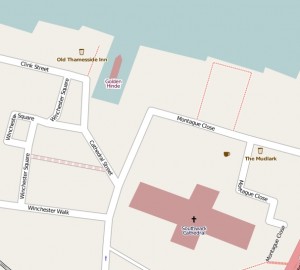
A chance find in a secondhand bookshop (thank you Kirkdale Bookshop) means I begin analysing the sanctuaries abolished in 1697 with Montague Close, in the environs of what is now called Southwark Cathedral.
The book is Florence Higham’s Southwark Story, published in 1955 to co-incide with the Golden Jubilee of the Cathedral and the Diocese of Southwark. Although sometimes sanctimonious, there are important details about the Close within it, and makes a suggestion I have not come across before, of sanctuaries as a place for religious dissidents.
An Augustinian priory was established on that site in 1106, dedicated to St Mary. It became known as St Marys Overy or Overie’s, meaning ‘over the river’ and was dissolved on October 14th 1539, with the remaining canons receiving a pension and lodging in the precincts. (Higham, p.99) (Higham’s book and the Southwark Cathedral website differ on details here: the former says 12 canons were there at the last, but implies only the Prior received housing, the later says 6 remained, all of whom “continued to live in the buildings north of the church”.)
As can be seen in the map above, Montague Close runs around three sides of the church building. It was named after Lord Montague, whose father, Sir Anthony Browne, “the man who benefited most from the sequestration” (Higham, p.100) had adapted the Prior’s house as his town residence. As it had once been part of the priory, it could be said to retain the rights of sanctuary attached to it, especially as the church remained in use. By the time of Elizabeth I, it was in “the hands of a family that remained true to the Pope, uneasy recusants more often than not were the guests that frequented Montague Close.” (Higham, p.122) Lord Montague had voted against her Act of Uniformity in 1559, asking “What man is there so without courage or stomach or void of all honour that can consent or agree to receive an opinion and new religion by force or complusion?” “The vote went against him but his loyalty to the Queen and to his religion did not falter. His commonsense honesty secured him many friends and he was undisturbed in his religion.” (Higham, p.138) War with Spain put an end to such tolerance, and “the prisons of Southwark were crowded with suspect Papists, in particular an ancient hostelry known as the White Lion, now set apart for this purpose. Government agents reported regularly that secret masses were held in the Marshalsea, that priests were hiding in Montague Close, that seditious speeches had been overheard.” Nevertheless, when Montague died, he left the Close to his wife, who maintained the support of her neighbours. (Higham, p.138)
By the 1620s, Montague Close was known as a sanctuary for debtors; Thomas Powell – who may have been the first to put into print the term Alsatia – mentions it in his Wheresoever you see mee, Trust unto Yourselfe: or the Mysterie of Lending and Borrowing. It consisted of “mean cottages and habitations for the poorer sort of people that crowded themselves together” – either there had been new building in the area, or the old buildings had been subdivided. (Higham, p.166) During the English Civil War, press gangs were reported in the liberties, Higham making the intriuging comment that the residents of Southwark were “for once unable to wrest to their advantage the conflicting jurisdictions.” (Higham, p.190) (I’ll return to the Interregnum and it’s effects on the liberties in a future post, as with Powell.)
The church, then known as St Saviours, was in the hands of Presbyterians, one of the ministers being a John Crodacott, a graduate of Magdalen, Oxford. He held that post until shortly after the restoration when he was ejected for not accepting the new Prayer book; a hardliner, the previous year he had tried to suppress the reinstitution of Christmas as a holiday, which led to “tumults …. in the streets.” However, he remained in the precincts, living in Montague Close in a house “with many ways to go out above and below.” (Higham, p.204) Very useful when one has to leave in a hurry! The immediate area became a refuge for Presbyterians and Independents, congregations setting up in the Close, The Clink / Deadman’s Place, and in Globe Alley, situated between the two sanctuaries. A house of Anabaptists and Fifth Monarchists was to be found on St Mary’s Dock (which now holds the Golden Hind, marked on the map above), bordering the Close but not actually part of it.
In 1706, a charity school opened in one corner of Montague Close (Higham, p.224-5); this can be taken as a sign of normality, the 1697 act being successfully implemented (although that does not go for the liberty of Southwark Mint). There was still religious defiance, but on the part of the Tories with Henry Sacheverell preaching his high Anglicism, and the successful opposition to the 1696 bill for ‘better regulation’ of the vestries.
Higham’s book is basically a religious history; there is only passing mention of debtors and criminals, who probably made up most of the population of the sanctuaries. Fair enough: she decides what she writes about. The idea of refuges for Catholics and dissenters, and the corresponding political importance of this, I have not seen elsewhere. Montague Close may be exceptional, as it was attached to a functioning church, whereas the monastery at Whitefriars was dissolved entirely, no religious institution taking its place. The vicissitudes of the time meant that those seeking sanctuary had once run the Church – first the Catholics, then the Presbyterians. This is very handy for putting down roots and getting local knowledge. But Montague Close was also a sanctuary for others as well. As ever, the historians’ fudge: More research is required!
Map generated from Open Street Map data under a CC-BY-SA license. Click to enlarge.
